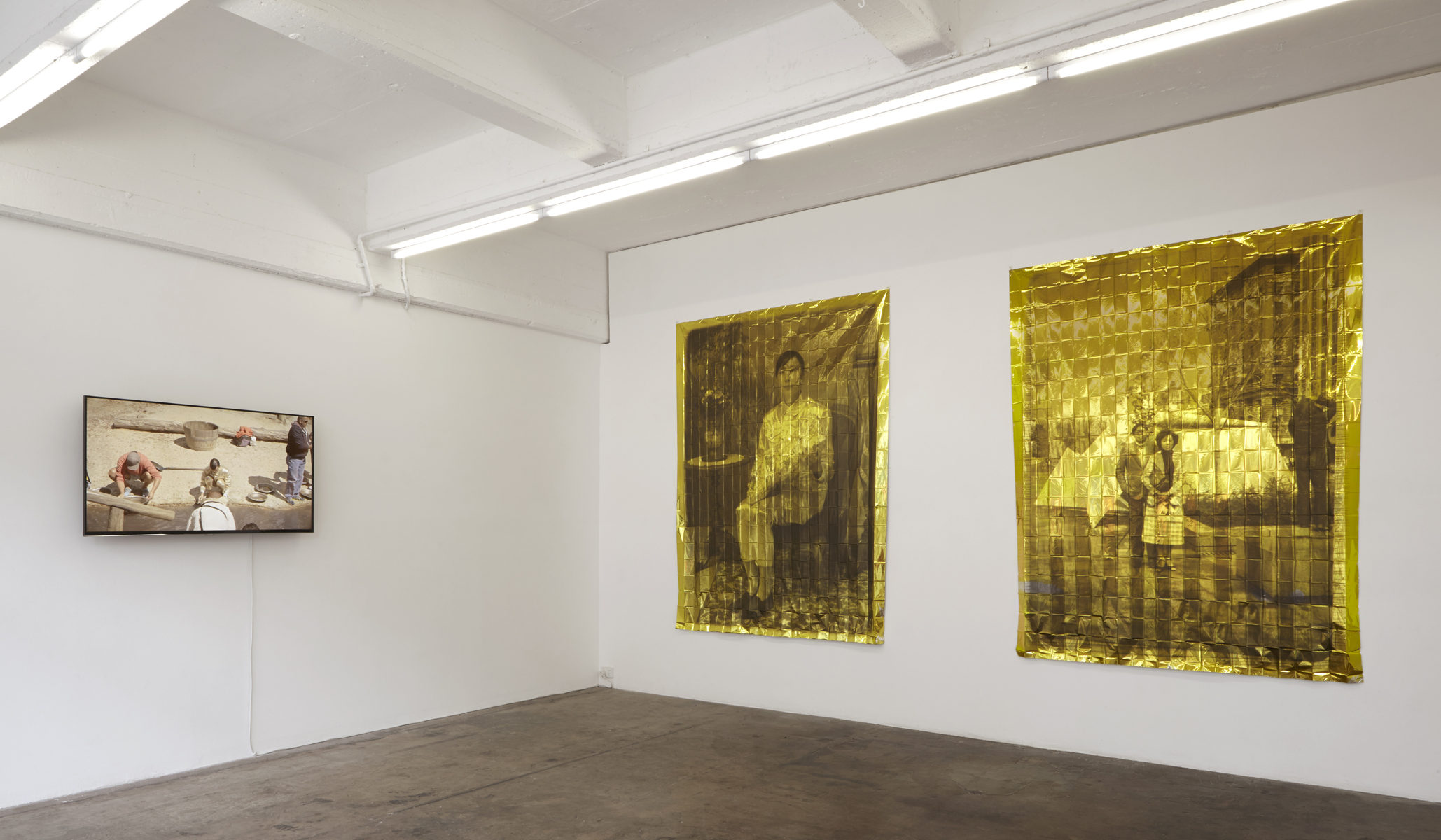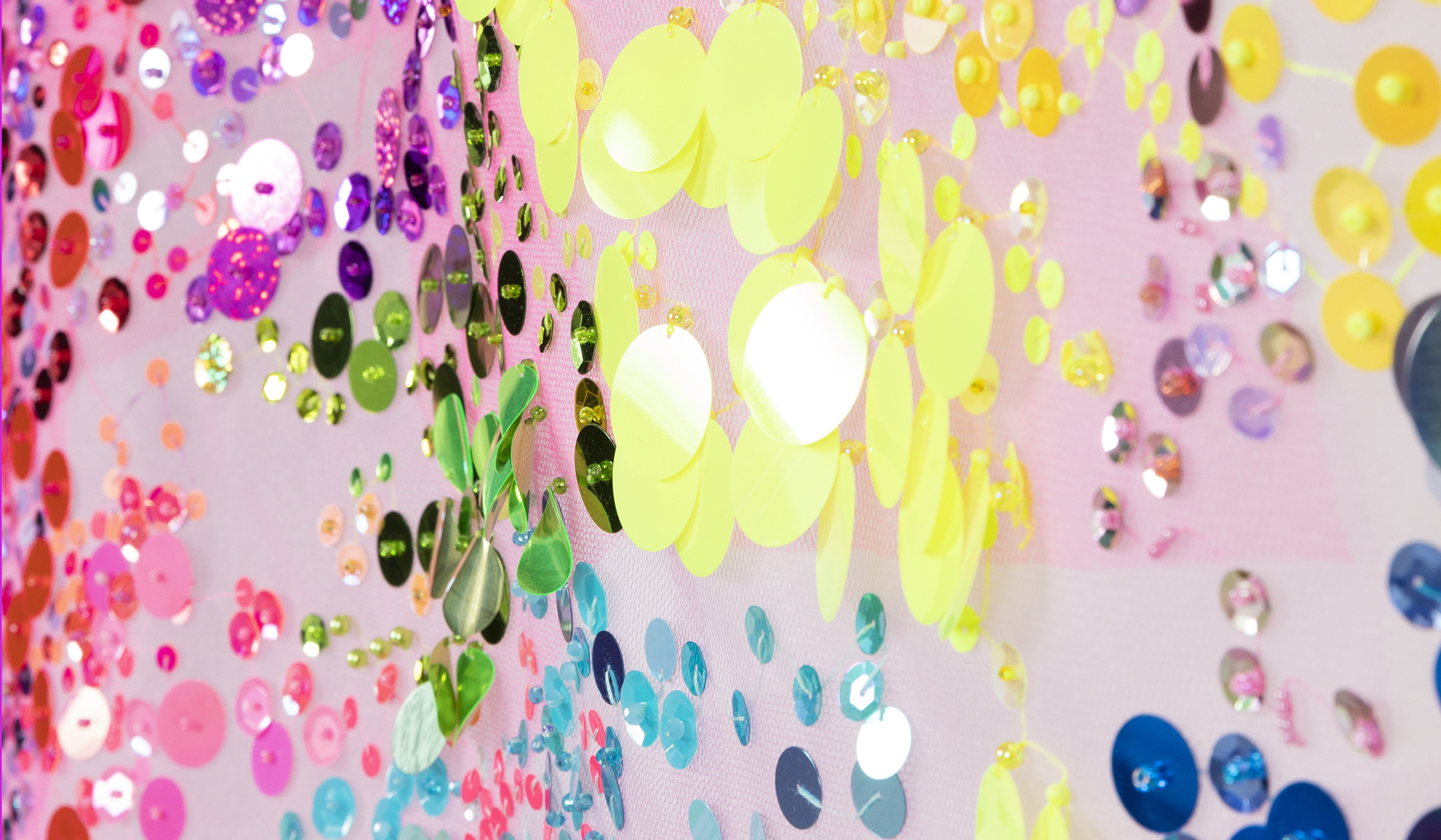Exhibition
Yellow Peril explores the impact and influence of mining and immigration on the Australian identity. Ron Robertson-Swann’s infamous Vault (1980) sculpture is the starting point for Eugenia Lim’s performative and playful new video work, which features a gold Mao-suited ‘Ambassador’ sent back in time to the goldfields of the 1850s (through the historical theme park of today – Sovereign Hill). Inspired by the observational comedy of Jacques Tati’s Playtime, Lim’s video work Yellow Peril takes a localised look at the evolving dynamics between Australia and China and the interconnected nature of our socio-economic future; the personal and political search for wealth and alluvial fulfilment. Large prints on gold emergency blanket depict Lim’s parents as new immigrants with the ‘Yellow Peril’ in City Square and the artist posed as ‘Ambassador’ with a gold replica of the ‘Welcome Stranger’.
In the bold cinematic masterpiece that is Playtime (1967), director Jacques Tati takes some of the most familiar shared spaces of French post-war society, and renders them strange. A visit to Paris by a group of provincial American tourists forms the film’s slim narrative pretext—the Americans arrive in a convoluted cityscape whose supposed modern conveniences conspire to trip, bewilder and ensnare these hapless interlopers. Playtime’s Paris is a literal House of Mirrors, a spatially interchangeable landscape that connects an airport terminal with an office lobby, a hotel, a home expo, an apartment complex, and a flashy new restaurant, all in one dizzying continuum. A running joke in the film is that the tourists never actually arrive in the French capital, but rather they spend their visit amiably negotiating the hypermodern simulacra of Paris. The ‘real’ or authentic city, if such a thing can ever be experienced, is sublimated by the signs and representations of Paris (an effect that was partially achieved through Tati’s construction of a 15,000 square-metre film-set replica on the outskirts of Paris).[i]
With its emphasis on simulation, globalisation and the touristic gaze, Playtime makes an instructive introduction to artist Eugenia Lim’s latest video work Yellow Peril (2015), which was filmed at the historical theme park of Sovereign Hill, a ‘living history’ museum that depicts life on the Ballarat goldfields in the 1850’s. Yellow Peril borrows from many of Playtime’s aesthetic tropes in order to explore the nuances of Australian nationalism, and to question Australia’s capacity to facilitate and resist the powers of globalisation. Specifically, the work navigates the fraught historical, political, economic and social dynamic between Australia and China, reminding us that whether it is a fear of immigrants, a fascination with the exotic or something in between, Australia has had a long and deeply ambivalent relationship to Chinese settlement.
Yellow Peril opens with a graceful pan across Sovereign Hill’s dusty and deserted landscape. The camera settles on a bright and shiny vista lined with faux 1850’s shopfronts, their hand-painted signs reading ‘New York Bakery’, ‘Glasgow Saddlery’, ‘United States Hotel’ and ‘Soho Works’ all evidence of the international capital present in the Victorian goldfields early-on. The viewer’s eye is soon drawn to a cast of anachronistic ‘readymade’ characters gathering in the street – iPhone-wielding tourists mingling with Sovereign Hill’s own period-actors.
A curious time-travelling flâneur dressed in a gold Mao suit simultaneously emerges from deep within the frame. Performed by the artist herself, this ghost from the future reinterprets Tseng Kwong Chi’s ironic East Meets West (1979-1989) photographic series, whereby Tseng’s self-constructed persona as an “inquisitive traveller and ambiguous ambassador” satirised relations between the United States and its emerging rival, China.[ii]
Indeed Yellow Peril’s ambiguous ‘Ambassador’ activates a chronological jump or temporal void in the work, which serves to amplify the tension between past and present, reality and fiction. The intermeshing of different time-periods confuses the linear clock-time inscribed within the Sovereign Hill experience, whose own history lessons are tethered to concepts of progress and chronological succession. Like narrative film, Sovereign Hill depends on its audience’s suspension of disbelief in order to function—the living history museum is extolled as a ‘time capsule’ contrived to take us ‘out of time.’ Unpicking this illusion of temporal wholeness, Yellow Peril also throws the ideological underpinnings of Australia’s whitewashed history into question.
The spatial rupture mobilised within Yellow Peril is another ideologically destabilising tactic. The constant overlapping of visual and aural information between the foreground and background scenes in the video commands multiple sources of attention. The viewer, lacking the direction usually provided by narrative filmmaking, is forced to actively pull focus in often-cacophonous scenes, just as in real life. In this way, Yellow Peril draws attention to the many conflicting, polyphonic histories happening in the world at any one time.
Presented beside the Yellow Peril video are two black-and-white photographic images digitally printed onto folded gold emergency blankets, themselves spectral objects loaded with mysterious metaphors. The first image, New Australians (Yellow Peril, 1980/2015), is a snapshot of the artist’s parents taken at City Square soon after their arrival in Melbourne. The young Chinese-Singaporean couple look hopeful as they stand before Vault (1980), Ron Robertson-Swann’s much-maligned public sculpture better known as “yellow peril.” Considered alongside the video, one is struck not only by the stockade-like quality of Robertson-Swann’s sculpture (and, by extension, its formal association with the Eureka Rebellion of 1854), but also by its residual power as a symbol of invasion.
Even as the Lim couple stand as the embodiment of optimism in their newly adopted country, the spectre of resentment and fear activated by the sculpture’s racist moniker hangs over the scene.
It could be suggested that artists are often our best historians of the present because they are at one and yet out of sync with their time. Unlike historians, who feel compelled to try to explain why the present had to evolve in exactly the way it did from what came before it, artists trade in making the lived elements of the present appear to be as unnatural, as inexplicable, as possible. To this end, the Yellow Peril installation harnesses the visual binary of real/simulation to reveal what Homi K. Bhabha regards as the postcolonial condition – simulation and realism, the global and the local, are proven to be contemporaneous and extant within each other’s space.[iii] The textual struggle within Yellow Peril transcends the boundaries of the visual to embody the tensions of competing global and local cultural identities.
Ulanda Blair (2015)
Ulanda Blair is Curator, Moving Image at M+ Hong Kong.
[i] Jacques Tati’s Paris was no ordinary film-set: ‘Tativille’ contained two four-storey buildings replete with central heating, escalators, and enough electrical power to generate sunlight on demand, along with tarmacked streets, working traffic lights, and several towering trompe l’oeil facades that could be rolled around to create multiple perspectives and building combinations.
See Kent Jones, Playtime, The Criterion Collection Film Essays, posted 3 June 2001, accessed 2 April 2015: http://www.criterion.com/current/posts/115-playtime
[ii] See Christine Lombard, East Meets West – Tseng Kwong Chi Documentary, 1984, posted 30 September 2009, accessed 5 April 2015: https://www.youtube.com/watch?v=Duery10DKB0&feature=youtu.be
[iii] Homi K. Bhabha, The Location of Culture, Routledge, London, 1994.
Eugenia Lim is an Australian artist who works across video, performance and installation. Interested in how nationalism and stereotypes are formed, Lim invents personas to explore the tensions of an individual within society – the alienation and belonging in a globalised world.
Lim’s work has been exhibited internationally at venues including the Tate Modern, Queensland Art Gallery and Gallery of Modern Art, the Australian Centre for the Moving Image, HUN Gallery NY, and FACT Liverpool. She has received a number of Australia Council for the Arts grants and residencies, including a residency at the Experimental Television Centre in New York and exchange at the Rhode Island School of Design (RISD).
Lim is currently exhibiting her video work ‘Yellow Peril’ at the 2016 ExIS Seoul International Experimental Film and Video Festival, where she is a finalist in the International Competition program. Eugenia is also one of three Australian artists currently undertaking a month-long residency facilitated by 4a Centre for Contemporary Asian Art at the studio of renowned Chinese- Australian artist Shen Shaomin.






